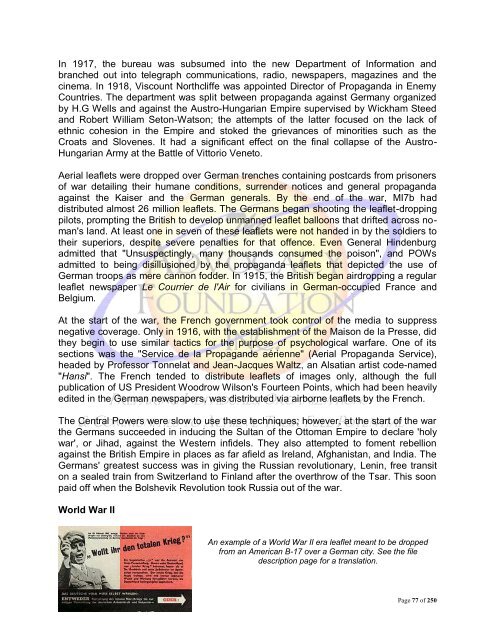Institutional Racism
Institutional Racism
Institutional Racism
Create successful ePaper yourself
Turn your PDF publications into a flip-book with our unique Google optimized e-Paper software.
In 1917, the bureau was subsumed into the new Department of Information and<br />
branched out into telegraph communications, radio, newspapers, magazines and the<br />
cinema. In 1918, Viscount Northcliffe was appointed Director of Propaganda in Enemy<br />
Countries. The department was split between propaganda against Germany organized<br />
by H.G Wells and against the Austro-Hungarian Empire supervised by Wickham Steed<br />
and Robert William Seton-Watson; the attempts of the latter focused on the lack of<br />
ethnic cohesion in the Empire and stoked the grievances of minorities such as the<br />
Croats and Slovenes. It had a significant effect on the final collapse of the Austro-<br />
Hungarian Army at the Battle of Vittorio Veneto.<br />
Aerial leaflets were dropped over German trenches containing postcards from prisoners<br />
of war detailing their humane conditions, surrender notices and general propaganda<br />
against the Kaiser and the German generals. By the end of the war, MI7b had<br />
distributed almost 26 million leaflets. The Germans began shooting the leaflet-dropping<br />
pilots, prompting the British to develop unmanned leaflet balloons that drifted across noman's<br />
land. At least one in seven of these leaflets were not handed in by the soldiers to<br />
their superiors, despite severe penalties for that offence. Even General Hindenburg<br />
admitted that "Unsuspectingly, many thousands consumed the poison", and POWs<br />
admitted to being disillusioned by the propaganda leaflets that depicted the use of<br />
German troops as mere cannon fodder. In 1915, the British began airdropping a regular<br />
leaflet newspaper Le Courrier de l'Air for civilians in German-occupied France and<br />
Belgium.<br />
At the start of the war, the French government took control of the media to suppress<br />
negative coverage. Only in 1916, with the establishment of the Maison de la Presse, did<br />
they begin to use similar tactics for the purpose of psychological warfare. One of its<br />
sections was the "Service de la Propagande aérienne" (Aerial Propaganda Service),<br />
headed by Professor Tonnelat and Jean-Jacques Waltz, an Alsatian artist code-named<br />
"Hansi". The French tended to distribute leaflets of images only, although the full<br />
publication of US President Woodrow Wilson's Fourteen Points, which had been heavily<br />
edited in the German newspapers, was distributed via airborne leaflets by the French.<br />
The Central Powers were slow to use these techniques; however, at the start of the war<br />
the Germans succeeded in inducing the Sultan of the Ottoman Empire to declare 'holy<br />
war', or Jihad, against the Western infidels. They also attempted to foment rebellion<br />
against the British Empire in places as far afield as Ireland, Afghanistan, and India. The<br />
Germans' greatest success was in giving the Russian revolutionary, Lenin, free transit<br />
on a sealed train from Switzerland to Finland after the overthrow of the Tsar. This soon<br />
paid off when the Bolshevik Revolution took Russia out of the war.<br />
World War II<br />
An example of a World War II era leaflet meant to be dropped<br />
from an American B-17 over a German city. See the file<br />
description page for a translation.<br />
Page 77 of 250

















